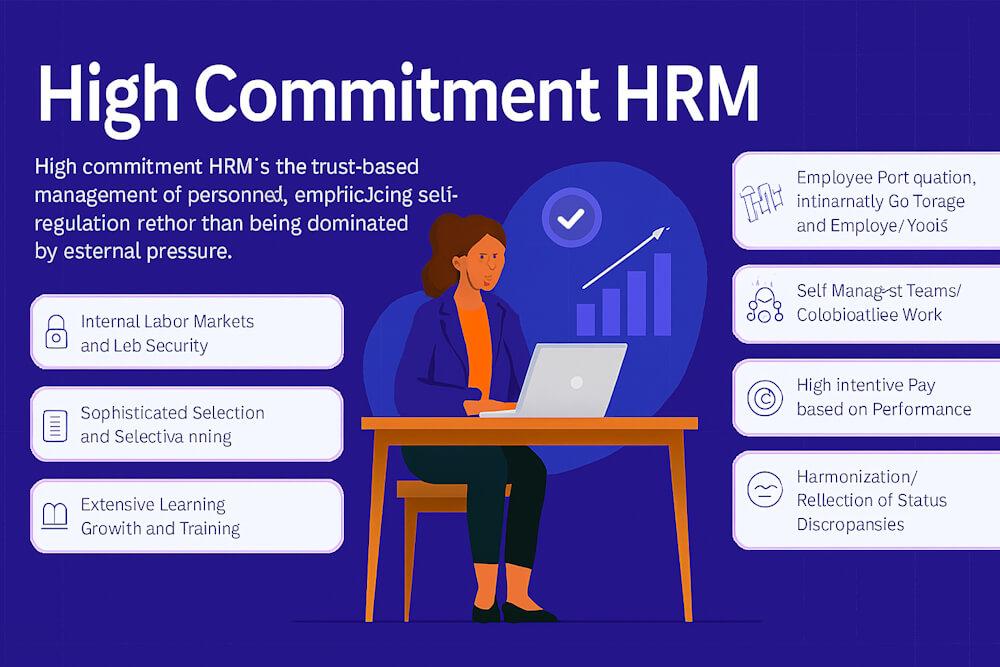Meaning
During the 1980s, when firms were confronting growing costs, diminishing productivity, and unsatisfied workers with high absenteeism rates, managers became more interested in the concept. Well-established (Tayloristic) control methods appeared to be exhausted. Since then, more and more high-commitment approaches have emerged. They improve organizational effectiveness by fostering an environment in which people are deeply invested in the organisation and strive tirelessly to achieve its objectives.
"Companies with strong commitment systems have higher productivity, financial performance, and effectiveness than organizations with low commitment or control systems," writes Whitener.
Human resource management (HRM) has progressed thanks to numerous approaches such as "high performance," "high commitment," "high participation," and "innovation." Coaker (2011) defines "HRM best practices" as "high performance work practices (HPWPs)," "high performance work systems (HPWSs)," "high commitment HRM (HCHRM)," and "universal HRM practices," with the underlying theme of these HRM approaches being the harnessing of human potential for organizational success.
The current study takes an HCHRM approach to HRM, with the goal of increasing organizational effectiveness by instilling employee commitment. Employee identification with the organisation will be strengthened and employees will be encouraged to exert effort to attain organizational goals if the organisation uses commitment-oriented HRM.
Employee perceptions of HCHRM are likely to be reflected in appropriate attitudes and behaviors, such as job satisfaction, affective commitment, and retention intention, as well as knowledge sharing behavior, innovation activities, organizational citizenship behavior, employee creativity, job embeddedness, and work engagement and commitment. The current study examines the impact of HCHRM on employees' service behavior in order to add to these areas of research.
High Commitment Human Resource Management (HCHRM) and Performance
HR practices, according to strategic human resource management (SHRM) researchers, have a direct impact on employees' attitudes and behaviors, which in turn has an impact on organizational performance. As a result, SHRM researchers have placed a greater emphasis on studying employee outcomes as a result of various HRM practices.
A strong commitment Human resource management is the trust-based management of personnel, emphasizing self-regulation rather than being dominated by external pressure. Studies have been conducted to see if best practices or high commitment HRM can improve organizational performance or improve a worker's performance.
The premise that certain human resource strategies can help to improve worker behaviors and attitudes, lower absenteeism and labor turnover, and boost productivity, quality, and customer service. This, it is claimed, has the end result of enhanced profitability.
However, not all studies find a link between best practice HRM and performance; there are questions concerning the HR practices that make up high commitment, their alleged connection to one another, the workers' and employers' attraction to it, and its universal application. Even if there is a link between high commitment HRM and performance, questions remain concerning the procedures and causes that create and underpin this relationship (Marchington and Wilkinson 2005).
Components of High Commitment HRM
According to Pfeffer (1998), the best practice or high commitment HRM components include:
- Job security and internal labor markets
- Intensive training, learning, and development
- Employee involvement and information sharing
- Teamwork
- High compensation depending on performance
- Reduction of status differentials/harmonization
1. Internal Labor Markets and Job Security
Employees cannot be expected to provide their time, ideas, and passion without some promise of job stability and concern for their future careers. Both the contribution of a positive psychological contract to open and trustworthy employment relationships (Holman et al 2003) and the notion of mutuality in partnership agreements being recognized as a vital component are related to this.
Managers and staff, for example, realise that the store would not be able to function without their help.
Clearly, job security can only be guaranteed to a certain extent. It doesn't mean that workers should stay in the same job or live the same life; it also doesn't mean that workers who don't perform to the required level should be fired, nor that a collapse in the market for a product that necessitates a reduction in the labor force should be viewed as an undermining principle.
Employment reductions will be avoided wherever possible, and employees will keep their jobs with the company, according to a high-commitment HR practice. Workers should not be viewed as a variable cost, but rather as a key asset to the company's long-term success and viability.
Laying employees off quickly, as (Pfeffer 1998) points out, is a cost for a corporation that has invested time in job selection, training, and growth of their workforce. Employees who have been laid off are valuable assets for the competitors to recruit.
Depending on whether information regarding practice or policy is needed, job security is measured in a variety of ways. Downsizing and compulsory layoffs, according to Pfeffer (1998, p183), jeopardise job security.
As alternatives, Pfeffer suggests the following:
- Reduce working hours proportionately to spread the pain of reduced employment costs across the workforce.
- Reduce payments to reduce labor costs.
- Prevent overstaffing by freezing recruitment.
- Engage production employees in sales to build up demand.
It is obvious that job stability will not have a negative impact on company profits. In the event of a decrease in demand, the employee's financial freedom is maintained by raising employee workloads and ensuring that payments are tied to performance.
2. Sophisticated Selection and Selective Hiring
Recruiting and retaining excellent individuals, as well as "collecting a store of extraordinary human talent," is an effective strategy to achieve long-term competitive advantage (Boxall 1996, pg66-67).
Although recruiters aim to hire the best people available, they use complex hiring procedures and exercise extreme caution when doing so. In addition to technical aptitude, employers need individuals with a variety of interpersonal, collaborative, and social abilities. Organizations were looking for dedication and trainability, according to Wood and Albanese (1995).
The proxies used to measure "selective hiring" vary a lot. They include:
- The number of applicants who are as good as the organisation requires.
- The proportion of applicants who are subjected to an employment exam before being hired.
- The sophistication of the selection processes.
- Job previews.
These measurements capture various aspects of the hiring process, depending on whether the focus is on the managers' general strategy or the tools used. Furthermore, when it comes to the quality of employees hired, some businesses prioritise inputs over outputs.
Selective hiring can result in under-representation of some groups, especially if it focuses on how new employees will fit into the existing company culture. An overabundance of 'cloning' of staff could be a problem if the organisation is focused on developing counterproductive, and variety and initiative if the market shifts.
3. Extensive Learning, Growth, and Training
Employees should be kept at the cutting edge of their area, both in terms of product knowledge and expertness, as well as through teamwork and interpersonal relationships.
One factor in organizational process advantage, according to Boxall (1996, pg67), is the idea that managers strive to synergize what outstanding and talented individuals are contributing.
As workers adopt skills-specific ways of training and experience, there has been a rising acknowledgment of individual workers' and organizational learning as a source of competitive advantage over other competitors.
Employer's use of the word 'learning' indicates a readiness to promote and encourage development rather than just offering particular training to address short-term crises.
The various sorts of measures that have been utilised include:
- Development of employees and programmes
- Assessments of interpersonal skills
- Task-based training
- Fully fledged learning organizations
The number of training days received by employees, the number of employees who have been trained, and the training budget are all examples of time and effort committed to learning opportunities.
It's critical to consider how much money and time a business is willing to invest in formal training, as well as whether it will cover the entire workforce.
It's also critical to determine the type of training required and who will be in charge of it. Many studies have focused on the financial side of training time and money invested while ignoring the training's significance.
4. Employee Participation, Information Exchange, and Employee Voice
Employee involvement is critical in the high commitment paradigm for two reasons:
- It ensures that employees are informed about company issues through communication about financial performance, operational matters, and strategy.
- It sends a message that employees should be trusted and treated positively.
In order for teamwork to succeed, employees must have access to information that allows them to make suggestions and contribute to improving corporate performance.
Third, employee participation provides management with justifications for any actions taken on the basis that the employees' opinions were presented before decisions were made (Marchington and Wilkinson 2005).
Even if an organization's management has more power than its employees, the employment relationship is not fully defined and established legally, and it is up to interpretation and argument about how it is enforced on a daily basis.
Information sharing is intended to improve individual employees' involvement in the organisation.
The combination of employee engagement approaches depends on the circumstances, however the measures utilised and the meaning of involvement are ambiguous.
Many studies focus on management-to-worker communication, assessing the frequency of information disclosure, the frequency of team briefings, and the extent to which workers are informed about corporate operations and performance.
Employee involvement is merely information from management; meaningful employee contribution is doubtful.
5. Self-Managed Teams / Collaborative Work
Managers have highlighted teamwork as a critical component of business success (Marchington 1999). It's also something employers seek for in new hires.
Teamwork is said to contribute to better decision-making and creative solutions (Pfeffer 1998, p76). Employees who work in teams have generally reported higher levels of satisfaction than those who work alone, yet they also indicate that they work hard.
The number of workers in a team, the utilization of formal teams, or the design of work to make use of employees' strengths are all examples of teamwork.
However, these metrics can't tell us whether these teams are autonomous or self-managed, and a lot depends on judgments like who leads the team, who is in charge of scheduling work, and who is in charge of quality control (Frobel and Marchington 2005).
6. High Incentive Pay Based on Performance
Performance-related pay and higher-than-average pay are the two aspects of this strategy, and both send the message to employees that they deserve to be rewarded for their outstanding achievements.
To be effective, it must be at a level that is above and beyond that of other organizations' employees in order to maintain and recruit high-quality labor.
Despite the fact that performance compensation has been questioned, it has been incorporated into best practice. It's a good idea to incorporate the complete package so that it's not only about money; it can also be about how employees contribute to performance, whether as a team, an individual, or a department.
7. Harmonization / Reduction of Status Discrepancies
In Japanese organizations, egalitarian manifestations are aimed to convey to lower-level workers and office staff that they are valued assets who should be treated equally to their senior counterparts.
Within the management culture, it is considered as a means to encourage staff to submit suggestions.
This may be observed in the shared canteen, car-parking facilities, and staff uniforms, all of which are egalitarian symbols, but it is also supported by the harmonization of working conditions and terms, such as pensions, sick-pay systems, and working hours (IRS employment review 784a 2003).
Moving from a single status to harmonization promotes and fosters teamwork and flexibility. Employee ownership, when properly implemented, can match workers' aspirations with those of shareholders by making them stockholders as well.
Performance Management and Human Resources
Huselid (1995) separated high commitment techniques into two categories:
- Worker motivation and skills, and
- Organizational structure
The latter is concerned with the number of employees who take part in attitude surveys, the amount of hours trained in the previous year, and the number of employees who must complete an employment exam as part of the recruiting process.
The former comprises the amount of employees whose performance reviews are tied to their pay, as well as the applicants who were hired the most frequently. Output measurements include labor turnover, financial performance, and productivity.







